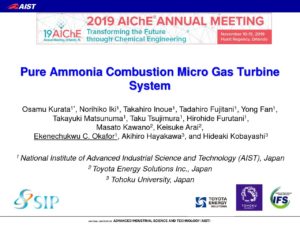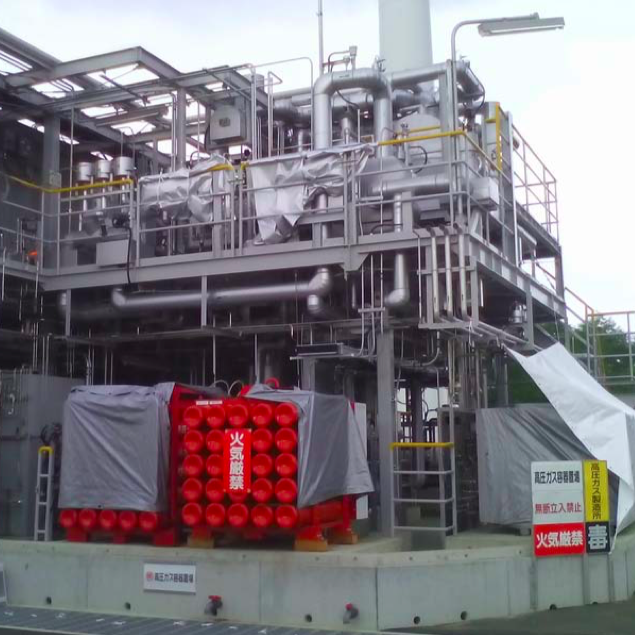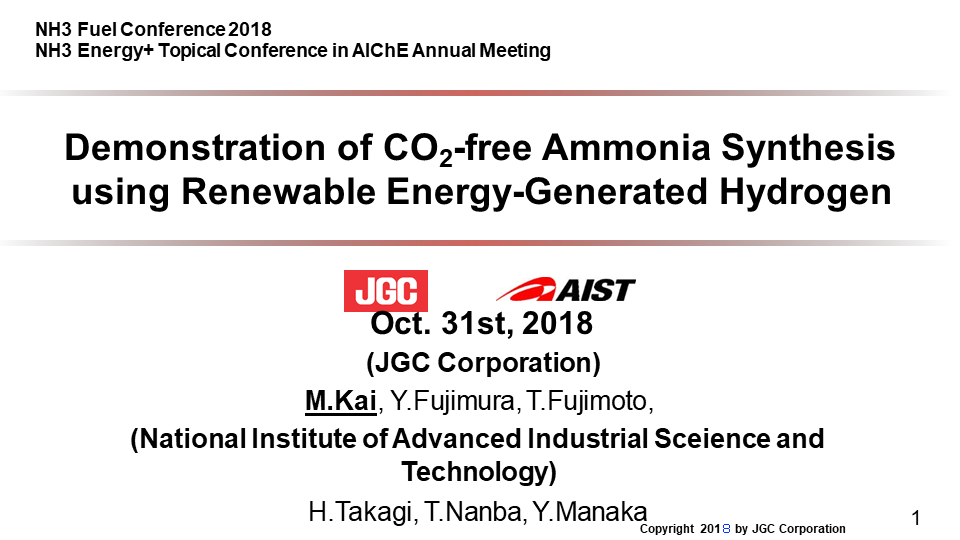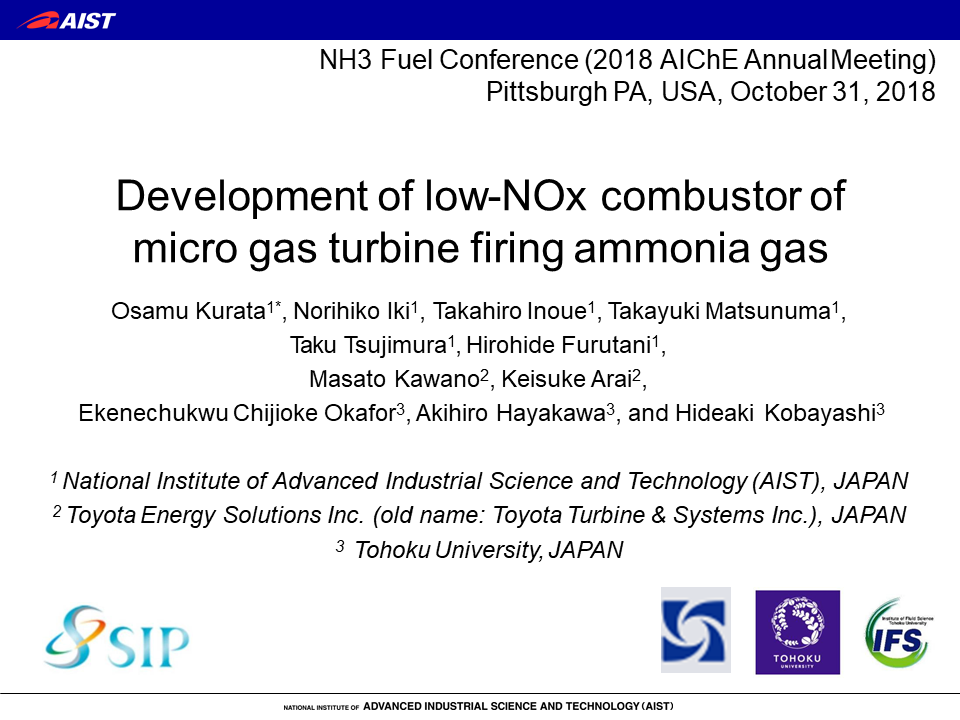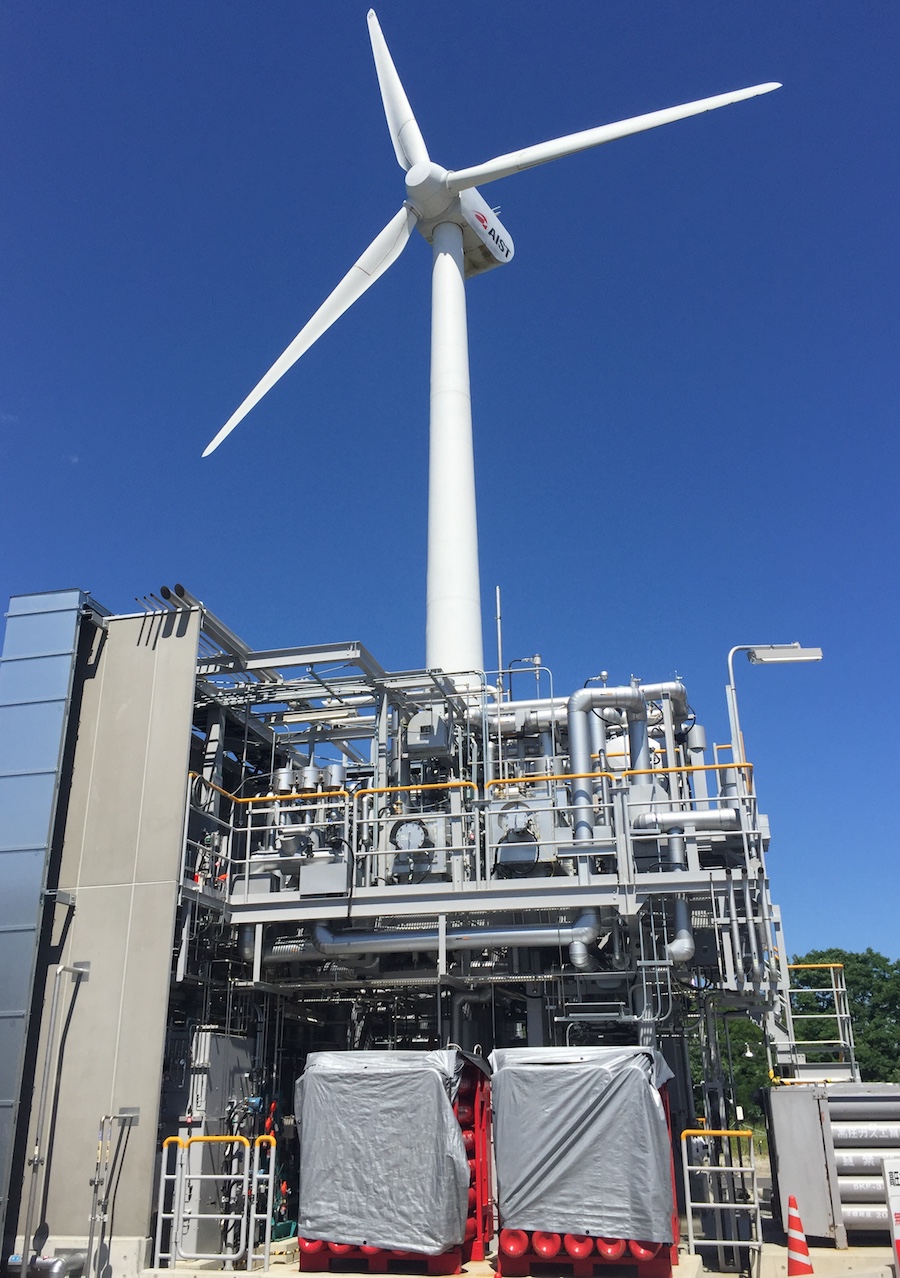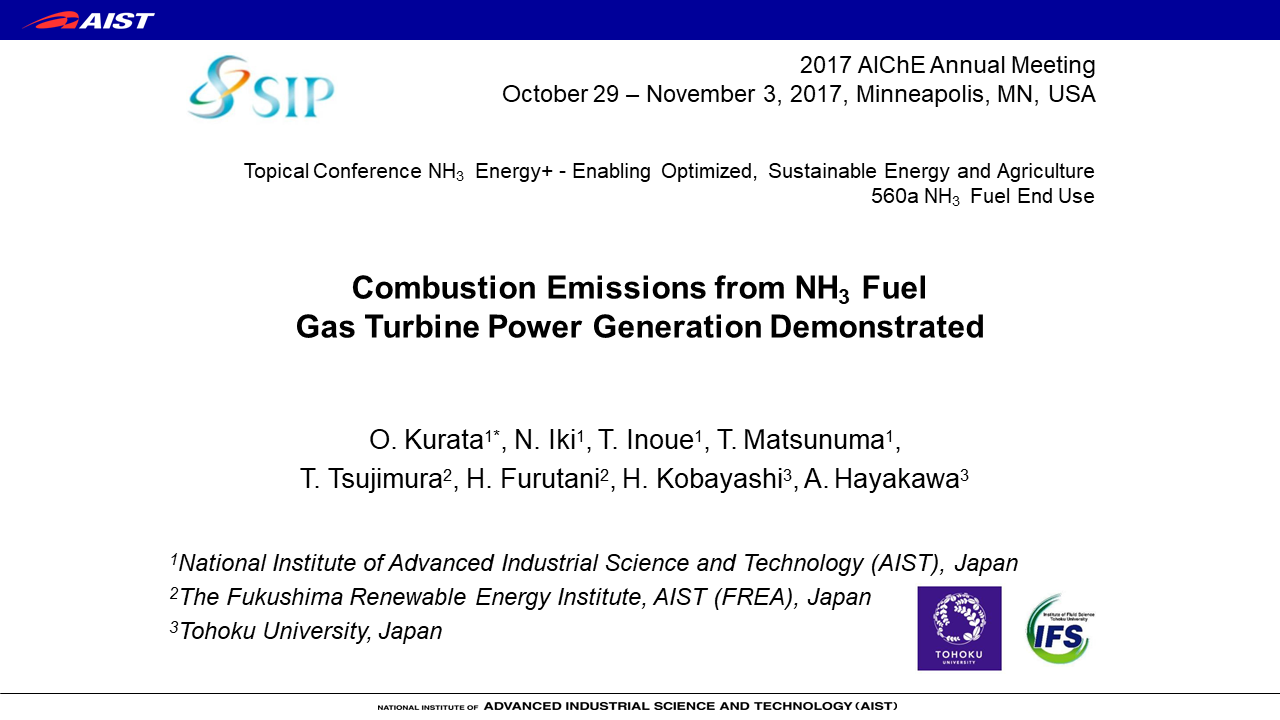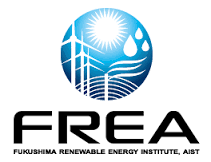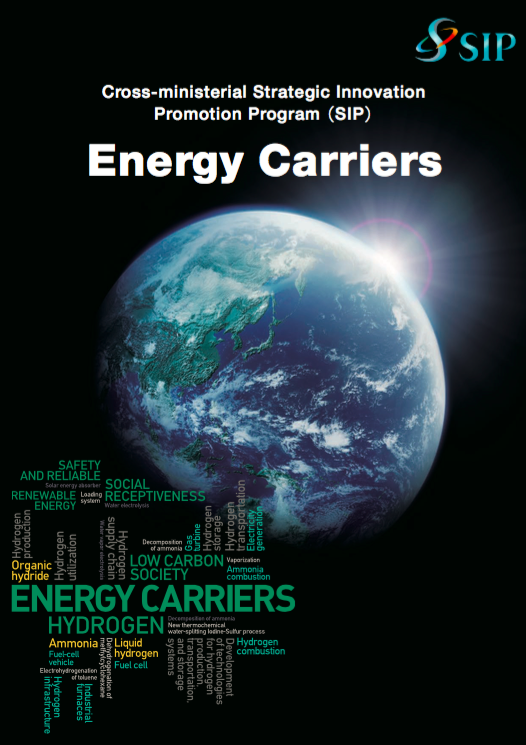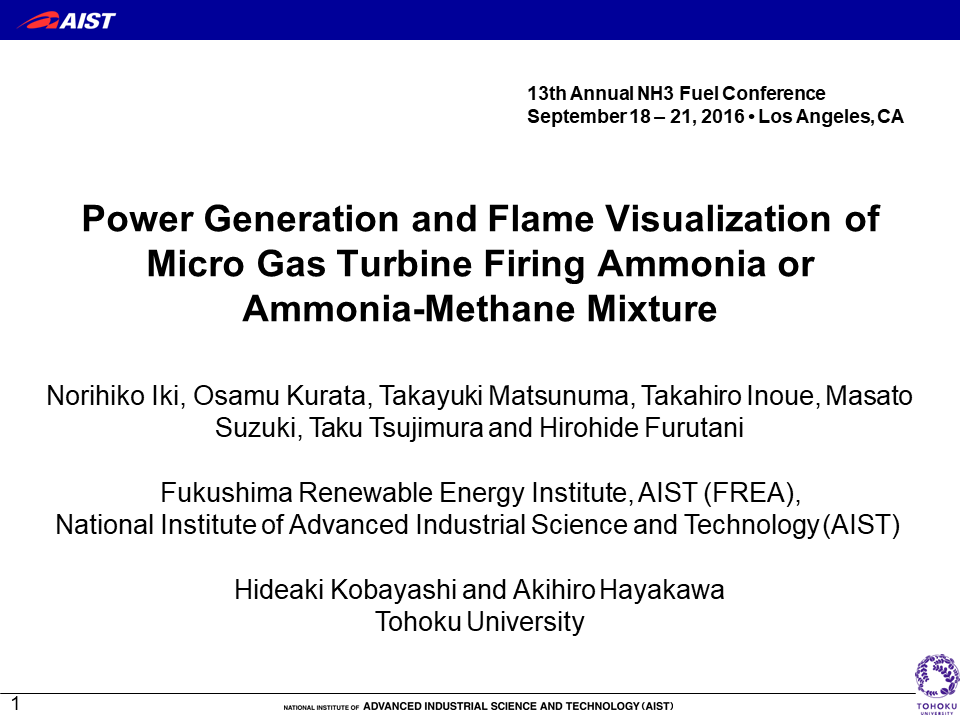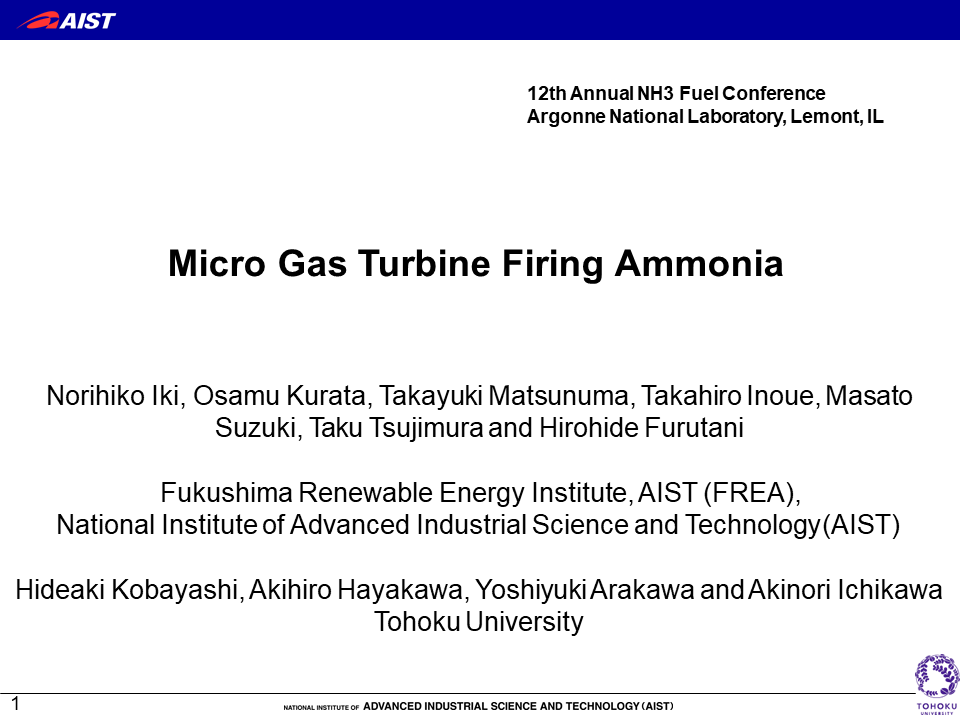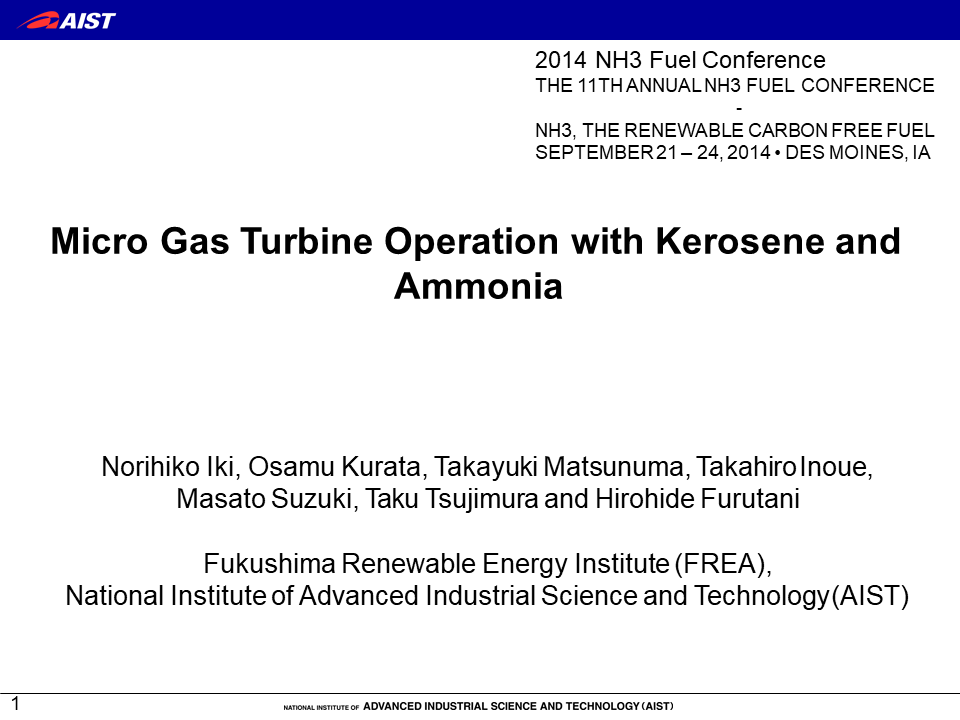Content Related to Fukushima Renewable Energy Institute
Presentation
Pure Ammonia Combustion Micro Gas Turbine System
Ekenechukwu Chijioke OkaforOsamu KurataNorihiko IkiTakahiro InoueTadahiro FujitaniYong FanTakayuki MatsunumaTaku TsujimuraHirohide FurutaniMasato KawanoKeisuke AraiAkihiro HayakawaHideaki Kobayashi
To protect against global warming, a massive influx of renewable energy is expected. Although hydrogen is a renewable media, its storage and transportation in large quantity has some problems. Ammonia fuel, however, is a hydrogen energy carrier and carbon-free fuel, and its storage and transportation technology is already established. In the 1960s, development of ammonia combustion gas turbines was abandoned because combustion efficiency was unacceptably low [1]. Recent demand for hydrogen energy carriers has revived the interest in ammonia as fuel [2, 3]. In 2015, ammonia-combustion gas turbine power generation was reported in Japan using a 50-kW class micro gas…
Article
JGC Corporation demonstrates "world's first" carbon-free ammonia energy cycle
Trevor Brown January 04, 2019
In late 2018, JGC Corporation issued a press release to celebrate a "world's first" in ammonia energy, demonstrating at its pilot plant in Koriyama both "synthesis of ammonia with hydrogen produced through the electrolysis of water by renewable energy, and generation of electricity through gas turbines fueled by synthesized ammonia." By demonstrating the feasibility of using ammonia on both sides of the renewable energy equation -- first, producing green ammonia from intermittent renewable electricity and, second, combusting this carbon-free fuel for power generation -- the project demonstrates the role of ammonia in the "establishment of an energy chain ... that does not emit CO2 (CO2-free) from production to power generation."
Presentation
Demonstration of CO2-Free Ammonia Synthesis Using Renewable Energy-Generated Hydrogen
In Japan, the government funding project SIP, Strategic Innovation Promotion Program, supports the research, development and demonstration of “Energy Carriers”. The concept of the “Energy Carriers” value chain is to produce hydrogen energy carriers overseas from fossil resources using CCS or renewable energy, and transport it to Japan for utilization as clean energy. The purpose of the program is to help realize a low-carbon society in Japan by using hydrogen. Among energy carriers, ammonia is the one of the most promising carriers, because of the ease of transportation as a liquid, higher hydrogen density, and proven technologies for commercial and…
Presentation
Development of Low-NOx Combustor of Micro Gas Turbine Firing Ammonia Gas
Osamu KurataNorihiko IkiTakahiro InoueTakayuki MatsunumaTaku TsujimuraHirohide FurutaniMasato KawanoKeisuke AraiEkenechukwu Chijioke OkaforAkihiro HayakawaHideaki Kobayashi
A massive influx of renewable energy is required in order to mitigate global warming. Although hydrogen is a renewable media, its storage and transportation in large quantity is difficult. Ammonia, however, is a hydrogen energy carrier, and its storage and transportation technology is already established. Although ammonia fuel combustion was studied in the 1960s in the USA, the development of an ammonia fuel gas turbine had been abandoned because combustion efficiency was unacceptably low [1]. Recent demand for hydrogen energy carrier revives the usage of ammonia fuel. The National Institute of Advanced Industrial Science and Technology (AIST) in Japan, in…
Article
Green ammonia demonstration plants now operational, in Oxford and Fukushima
Trevor Brown June 29, 2018
Two new pilot projects for producing "green ammonia" from renewable electricity are now up and running and successfully producing ammonia. In April 2018, the Ammonia Manufacturing Pilot Plant for Renewable Energy started up at the Fukushima Renewable Energy Institute - AIST (FREA) in Japan. Earlier this week, Siemens launched operations at its Green Ammonia Demonstrator, at the Rutherford Appleton Laboratory outside Oxford in the UK. The commercial product coming out of these plants is not ammonia, however, it is knowledge. While both the FREA and Siemens plants are of similar scale, with respective ammonia capacities of 20 and 30 kg per day, they have very different objectives. At FREA, the pilot project supports catalyst development with the goal of enabling efficient low-pressure, low-temperature ammonia synthesis. At Siemens, the pilot will provide insights into the business case for ammonia as a market-flexible energy storage vector.
Presentation
Combustion Emissions from NH3 Fuel Gas Turbine Power Generation Demonstrated
Osamu KurataNorihiko IkiTakahiro InoueTakayuki MatsunumaTaku TsujimuraHirohide FurutaniHideaki KobayashiAkihiro Hayakawa
To protect against global warming, a massive influx of renewable energy is expected. Although H2 is a renewable media, its storage and transportation in large quantity is difficult. NH3 fuel, however, is an H2 energy carrier and carbon-free fuel, and its storage and transportation technology is already established. Although NH3 fuel combustion was studied in the 1960s in the USA, the development of an NH3 fuel gas turbine had been abandoned because combustion efficiency was unacceptably low [1]. Recent demand for H2 energy carrier revives the usage of NH3 fuel, but no one has attempted an actual design setup for…
Article
SIP "Energy Carriers" video: ammonia turbines, industrial furnaces, fuel cells
Trevor Brown October 13, 2017
To demonstrate the progress of the SIP "Energy Carriers" program, the Japan Science and Technology Agency last week released a video, embedded below, that shows three of its ammonia fuel research and development projects in operation. R&D is often an abstract idea: this video shows what it looks like to generate power from ammonia. As it turns out, fuel cells aren't hugely photogenic. Nonetheless, if a picture is worth a thousand words, this will be a long article.
Article
On the Ground in Japan
Stephen H. Crolius February 09, 2017
Two talks delivered in December show the tiny steps that allow a country to transition to a sustainable energy economy. The country is Japan. The events hosting the talks were short-format symposia whose evident objective was to draw in business and technical people who might become practically involved in the new energy economy. Both talks highlighted the role to be played by ammonia while also describing competing and complementary technologies.
Article
Ammonia Turbine Power Generation with Reduced NOx
Trevor Brown October 06, 2016
A common concern with ammonia fuel is that NOx emissions will be too high to control. However, in new research from Turkey, USA, and Japan, presented at this year's NH3 Fuel Conference in September 2016, two things became clear. First, NOx emissions can be reduced to less than 10ppm by employing good engineering design and exploiting the chemical properties of ammonia, which plays a dual role as both the fuel and the emissions-cleanup agent. Second, the deployment of ammonia-fueled turbines for power generation is not only feasible, but actively being developed, with demonstration units running today and improved demonstration projects currently in development.
Presentation
Power Generation and Flame Visualization of Micro Gas Turbine Firing Ammonia or Ammonia-Methane Mixture
Norihiko IkiOsamu KurataTakayuki MatsunumaTakahiro InoueTaku TsujimuraHirohide FurutaniHideaki KobayashiAkihiro Hayakawa
A demonstration test with the aim to show the potential of ammonia-fired power plant is planned using a micro gas turbine. 50kW class turbine system firing kerosene is selected as a base model. A standard combustor is replaced to a prototype combustor which enables a bi-fuel supply of kerosene and ammonia gas. Diffusion combustion is employed to the prototype combustor due to its flame stability. 44kW power generation was achieved by 100% heat from ammonia gas. Although NOx concentration in the exhaust gas of ammonia combustion exceeded 500ppm, NOx removal equipment reduced NOx concentration below 10ppm. Over 30kW power generation…
Presentation
Micro Gas Turbine Firing Ammonia
Norihiko IkiOsamu KurataTakayuki MatsunumaTakahiro InoueMasato SuzukiTaku TsujimuraHirohide FurutaniHideaki KobayashiAkihiro HayakawaYoshiyuki ArakawaMasanori Ichikawa
Micro Gas Turbine Firing Ammonia Norihiko Iki*, Osamu Kurata, Takayuki Matsunuma, Takahiro Inoue, Masato Suzuki, Taku Tsujimura and Hirohide Furutani, National Institute of Advanced Industrial Science and Technology (AIST), Fukushima Renewable Energy Institute (FREA); Hideaki Kobayashi, Akihiro Hayakawa, Yoshiyuki Arakawa, Masanori Ichikawa, Institute of Fluid Science, Tohoku University
Presentation
Micro Gas Turbine Operation with Kerosene and Ammonia
Norihiko IkiOsamu KurataTakayuki MatsunumaTakahiro InoueMasato SuzukiTaku TsujimuraHirohide Furutani
A demonstration test with the aim to show the potential of ammonia-fired power plant is planned using a micro gas turbine. 50kW class turbine system firing kerosene is selected as a base model. A standard combustor is replaced with a prototype combustor which enables a bi-fuel supply of kerosene and ammonia gas. Diffusion combustion is employed to the prototype combustor due to its flame stability. Demonstration test of co-firing of kerosene and ammonia gas was achieved to check the functionality of the each component of the micro gas turbine. The gas turbine started firing kerosene and increased its electric power…
